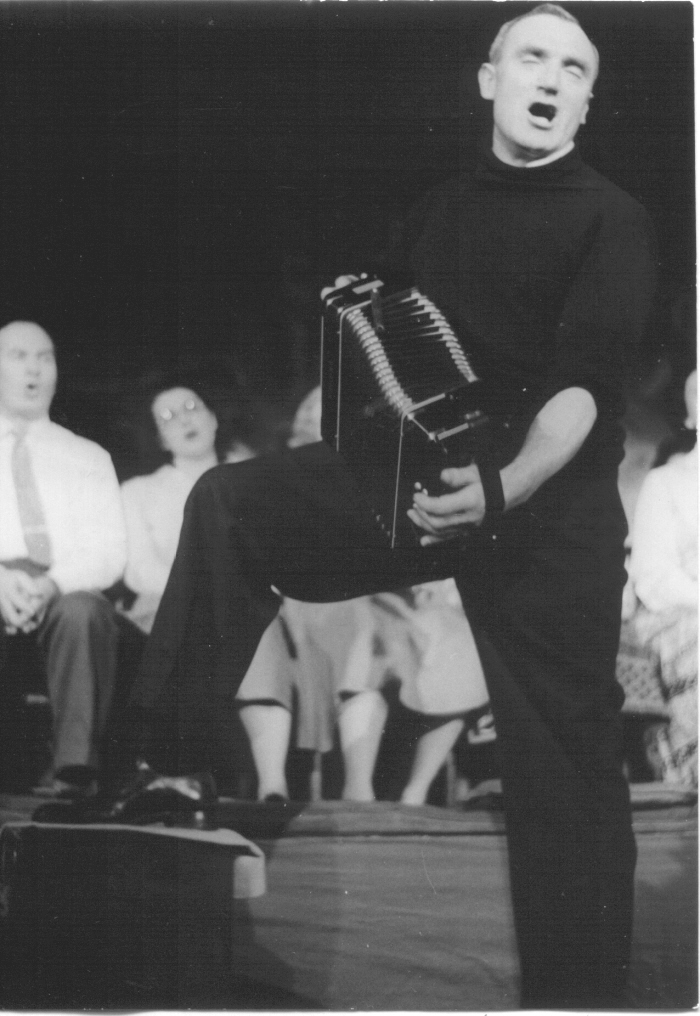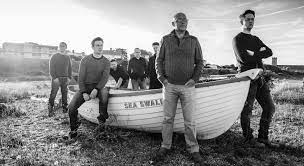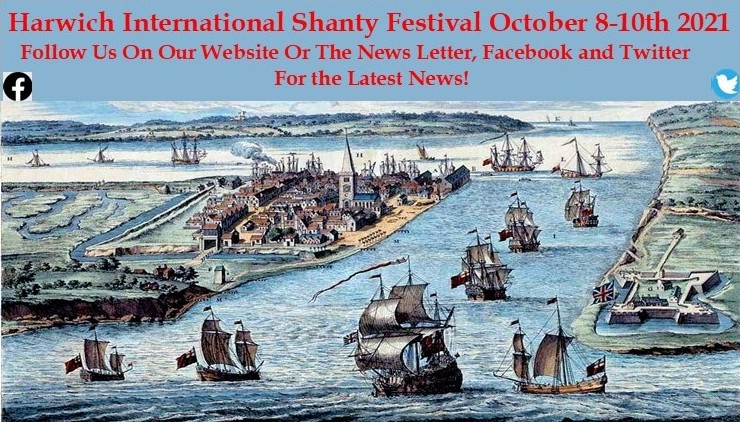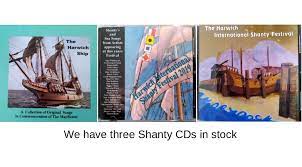by Debbie Jones – Press Officer, Harwich Shanty Festival
March 2021
During lockdown a Scottish postman, Nathan Evans, posted a sea shanty on TikTok that sparked a world wide craze, his biggest hit being the New Zealand shanty “The Wellermanâ€.
There is now a huge amount of new interest and enthusiasm for shanty singing. Many people confuse ‘songs of the sea’ and ‘shanties’, but the difference is that the sea shanty is a traditional working song.
The word shanty, chantey or chanty seems to date back to the mid 19th century, possibly derived from the French word ‘chanter’, to sing, or the English chant, as in the religious Gregorian chants. Although the word is comparatively new, examples of shanties date back to the fifteenth century. The heyday seems to have been the 19th century, and most surviving examples date from that time, although there are a few from the 18th century.
Much of the music from this time has been preserved for posterity by Cecil Sharp and Stan Hugill. However, the sea shanty is very much a living tradition and the singing of the shanty and its composition has continued right up to the present time.
At a time when manpower was the only source of power and energy on board a ship or sailing vessel, these rhythmical songs served a practical purpose, with the rhythm of the songs synchronizing the work of the sailors on board as they worked at their repetitive tasks. The shanties also boosted morale as they relieved boredom and fostered a feeling of camaraderie. The shanty was considered such an important aid to the efficient working of the crew that a Shantyman was often employed on board vessels to co-ordinate the work.
Most shanties have a ‘call and response’ formula where the Shantyman sings a line and the crew respond with another, but different shanties were used to cover different types of work on board ship. A long, slow job such as hauling on a rope or halyard would call for a long, measured Halyard Shanty. Turning the capstan to haul up the anchor called for a smoother, more regular Capstan Shanty, while pumping the bilges required a Pumping Shanty. There are also many songs the sailors would sing for their own amusement when not working, and these are usually grouped together as ‘Forebitters’. Shanties were sung predominantly in the merchant navy while the Royal Navy discouraged noise on board with the view that orders should be clearly heard. However, ‘Forebitters’ were still sung when off duty and a ships fiddler or flautist was often employed to accompany some tasks on board.
Historically shanties were not usually sung ashore, but nowadays they are popular in many countries, particularly, but not exclusively, those with a seafaring tradition. In mainland Europe, many countries favour large shanty choirs, whereas many English speaking countries favour smaller groups. Although the days of the “Tall Ships†are gone, the shanty lives on and its popularity has inspired new musical compositions and shanties are sung at pubs, clubs and festivals throughout the world.

Stan Hugill
Photo chantycabin.co.uk
Bob Roberts
Photo Eddis Thomas
Jim Lawrence
Photo classicsailor.com
Rogue Shanty Buoys
Photo Rogue Shanty Buoys
East Anglia is a region steeped in seafaring history with shanties and musical tradition connected with the merchant navy, fishing, whaling and smuggling as well as the iconic Thames sailing barges, a type of commercial sailing boat once common along the East Coast and the River Thames in London, many of which were built at Maldon and Harwich. East Anglia is ideally situated to benefit from trade links with Denmark and Holland, which have brought prosperity and maritime importance to the region’s ports.
In Suffolk, The Voice Cloud is a not for profit arts and music organisation based in Kessingland with the aim of exploring the social and historical importance of folk music and work songs created by the fishing and seafaring communities of Suffolk and East Anglia. The project has included school workshops, talks and demonstrations to local groups, music workshops and has engaged with almost 2000 participants. It was founded by two members of a shanty group, ‘The Rogue Shanty Buoys’, who have now also formed ‘The Rogues Shanty Chorus’, a unique choir based in Lowestoft who sing the songs of fishermen and sailors, celebrating the culture and legacy of local seafaring communities by reviving the folk music that they created in order to celebrate the musical heritage of the East Anglian coast.
One notable East Anglian character was Bob Roberts (1907 to 1982). A barge skipper who at one time lived in Pinmill, Suffolk, and was a singer, songwriter, story teller, author and journalist. He was the last captain of a British commercial vessel operating under sail, bringing to an end a centuries old tradition. Another one of the last surviving commercial barge skippers is shanty singer Jim Lawrence who later ran a sail making business at Brightlingsea in Essex.
Harwich Shanty Festival

Harwich is steeped in maritime history with its links to the Mayflower, its long tradition of ship building at the Navyard Wharf, Thames barges built at Gas House Creek and also the fishing trade. Ships have been built in Harwich for hundreds of years. Its shipyard was inspected by Queen Elizabeth 1 in 1561. As shanties also date back hundreds of years, it seems likely that many a shanty has been sung by sailors on Harwich ships! It is therefore an ideal place to host one of the UK’s biggest shanty festivals.
Harwich International Shanty Festival is now in its 16th year and has become a major event bringing together shanty groups from the local town of Harwich, East Anglia, the rest of the UK as well as international groups from far and wide. It has journeyed a long way since its small beginnings with a bunch of friends meeting up in a couple of pubs to drink good beer and sing good shanties, but the initial idea of a cosy pub atmosphere, real ale, good friends and rousing shanties is still where its core values lie. In those sixteen years the Festival has grown to become the Premier UK Shanty Festival and over the Festival weekend the historic town of Old Harwich resounds with the sound of Shanties and Sea Songs, with pub sessions, concerts, barge trips, street theatre, maritime crafts, pirates, a Shanty train and much more.
Groups from East Anglia feature strongly in the festival. Some groups from Norfolk include ‘The Sheringham Shantymen’, who support the RNLI as their main charity, and the all women group, ‘The Norfolk Broads’. Suffolk groups include ‘The Rogue Shanty Buoys‘ mentioned previously, ‘The Rum Old Boys’ from Woodbridge, ‘The Shotley Crue’, and ‘The Felix Stowaways.’ Essex groups include ‘Motley Crew’ from Brightlingsea, ‘The Hoolies’ from Wivenhoe and ‘Mains ‘l Haul’ from Maldon, who can boast an authentic Thames Barge Skipper amongst their number. Harwich also have three of its own shanty crews – ‘The Naze Shanty Crew’, founders of the Harwich Shanty Festival and formerly based at Walton-on-the Naze, the ‘Rattlin’ Winches’ and the ‘Harwich Shanty Crew’, a community group formed from a workshop at the 2010 festival and still going strong! Len Smith, a local artist who sings in all three Harwich groups and is a festival committee member, designed the last festival T-shirt which featured a Harwich Bawley on which their catch of shrimps would be boiled before returning to port. HH27, the “Boy Len†was the last fishing vessel to work under sail out of Harwich, in the late 1940s and was owned and sailed by brothers John and Ern Smith. They named their boat after their nephew, Len “Archie†Smith, who later became Chief Coxswain of the Trinity House pilot launches and father of our own Len Smith!
Last year’s shanty festival sadly had to cancelled but as the world emerges from Lockdown and with the ongoing success of the vaccination programme, the festival committee are excited to announce that the Harwich International Shanty Festival 2021 is definitely set to run on the weekend of 8th to 10th October. Due to uncertainty over exactly how the world will look by October, the 2021 festival will look slightly different from usual. Headline acts cannot be announced until a little later in the year, but Mayflower 400 will definitely be the theme.
For up to date information visit the website harwichshantyfestival.co.uk and follow the festival on Facebook, Twitter and Instagram.
